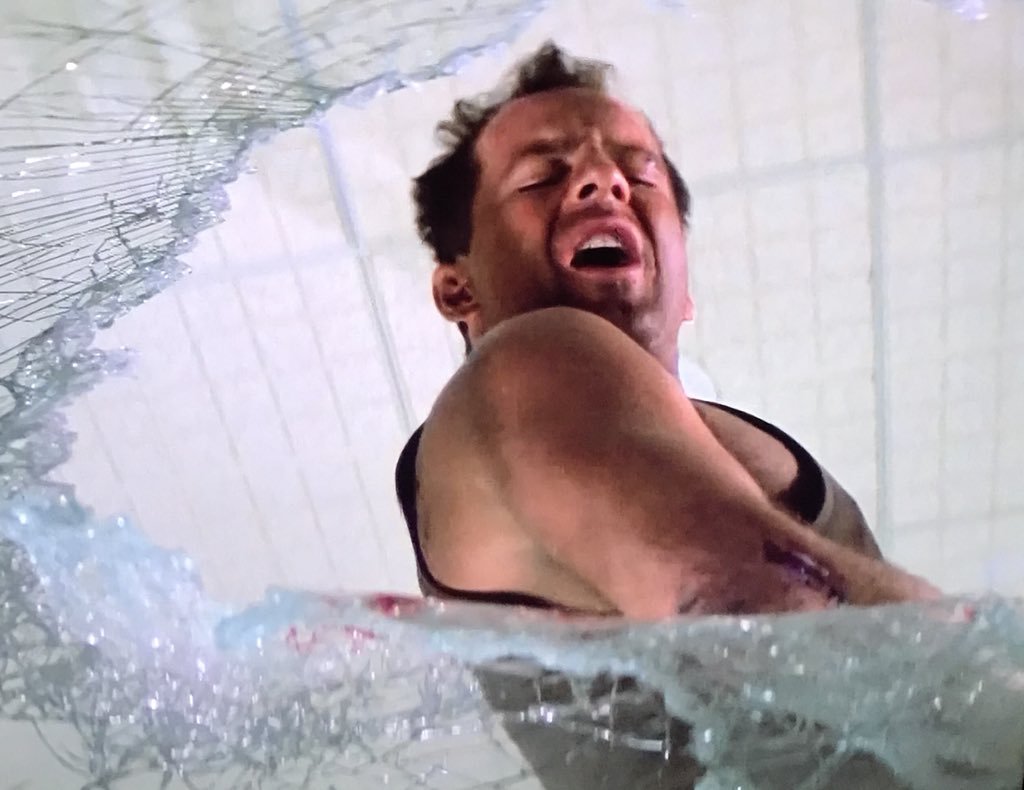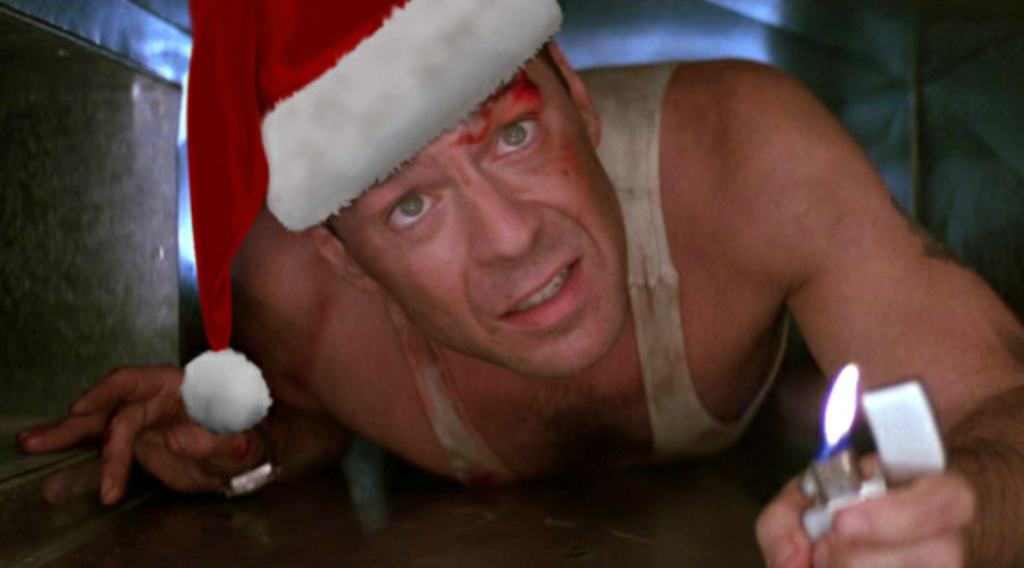After Action Review: How John McClane Could Have Better Defended Nakatomi Plaza in ‘Die Hard’

Bruce Willis as John McClane in “Die Hard.” Photo courtesy of IMDB.
There is a saying in the military that you’re only as good as your last operation. With that reasoning we always strived to be better, even after a great showing. One of the ways we did that was through a savagely honest self-assessment of our performance after the mission, whether in training or on a real-world op. This was achieved in an after action review, or AAR.
With Christmas upon us, there’s a higher likelihood for intricate terrorist attacks plotted by international criminal masterminds. With this increased threat level, we have basically one place to turn if we want to thwart these attacks and keep our country and the world safe. That place of safety is in the sinewy arms of tank-top-clad Det. John McClane. Although he has achieved heroic status due to his prowess at Nakatomi Plaza, McClane’s execution was far from perfect.
A written AAR that is broadly distributed for discussion is most often broken down into the setup of the situation and a brief summary of events, followed by specific topics of issue, discussion, and recommendation. This allows for critical analysis and tangible critiques, rather than being just a gripe session. And even though we’re going after a great American hero in this one, thin skin has no place in the AAR — especially when you have as much room for improvement as John McClane, Nakatomi Security, and the Los Angeles Police Department have in their fight against Hans Gruber and his German cronies.
Situation: A group of German robbers forced their way into Nakatomi Plaza to steal more than $600 million in bearer bonds. We call them “robbers” because although they send demands based in political terms, that is actually a ruse to set them up to fake their own deaths once the FBI inevitably, according to plan, arrives to rescue the hostages. But something gets in their way when McClane, of the New York Police Department, happens to be the guest of his estranged wife at the company Christmas party. As McClane cleans up after his long flight, Hans Gruber and about 15 other Germans storm the building and take every partygoer, minus McClane, hostage. Then begins the struggle for McClane to rescue his wife and the other hostages while fighting not only the terrorists but also the overall incompetence of the LAPD and FBI.
Issue: Complacent Mindset
Discussion: Throughout the initial development of the situation, every level of security is complacent. This begins with McClane basically brandishing his “concealed” weapon on a commercial flight to him being waved through security without so much as a cursory check of his ID as his limo drives unchallenged into an underground parking garage. This continues on to the next security guard, who watches McClane board an elevator into the building and up to more than 40 employees and $600 million worth of bearer bonds.
Recommendation: With great power comes great responsibility. So McClane, being under arms throughout this ordeal, should be expected to at all times maintain a combat mindset. Not only should HE be in this mindset, but as an experienced law enforcement officer he should hold accountable other security professionals when presented with lackadaisical SOPs (standard operating procedures). McClane should therefore write an updated Nakatomi Plaza Entry Control SOP and run a minimum 40-hour block of instruction to all of its employees, to include concealed carry and entry control point security postures. This should be followed by periodic spot-checks and attempted breaches of security by independent role players to ensure no stagnation of mindset can occur.

Issue: Close-Quarters Battle Tactics, Techniques, and Procedures
Discussion: Principles of CQB can be argued ad nauseam but are generally dissected from the old “speed, surprise, violence of action.” These principles are catchy and great on a T-shirt, but what do they mean? Basically they are used together in varying percentages, based on the scenario, to overwhelm and defeat an enemy force in close combat. The first thing to strive for is fire superiority, or getting as many guns in the fight as possible at the correct point in time and space. McClane was alone and engaged with the enemy without support against a numerically superior force able to fire and maneuver on him throughout the crisis. Speed and violence of action are wasted if they’re applied at the wrong time, which was the case at Nakatomi. It should also be noted that McClane’s weapons manipulations, comms practices, noise discipline, and marksmanship were abysmal, but for the sake of brevity those can be addressed in later training. We won’t bring up the shoe thing either …
Recommendation: Given the clear objective, in future scenarios McClane should mass combat power before beginning offensive actions. This could be accomplished by exercising a tactical withdrawal and utilizing nonstandard comms to paint the picture for follow-on forces. The lone operator on the objective should act less as lead assaulter and more as armed reconnaissance. As he establishes comms and organizes follow-on forces, he should also be identifying and passing on possible breach points, enemy situation updates, and other pertinent information. Additionally, the Nakatomi towers should be outfitted with multiple redundant systems of communication powered by secondary and tertiary sources.
Issue: Unity of Command
Discussion: Throughout the crisis McClane could not paint a clear picture due to an ununified reaction force. One hand was not washing the other as ego and politics handcuffed the few individuals with eyes on the situation and guns in the fight.
Recommendation: Put Carl Winslow in absolute command.
Merry Christmas — and yippee ki yay, motherfuckers.

Jariko Denman is a contributing writer for Coffee or Die. He is a retired US Army Ranger and deployed to combat 15 times in Iraq and Afghanistan from 2002 to 2012, amounting to 54 months of total combat experience as part of a Joint Special Operations Task Force. He now lives in Los Angeles and has advised on several major motion pictures, national ad campaigns, and television series as well as continuing to train and work within government and tactical industries.
BRCC and Bad Moon Print Press team up for an exclusive, limited-edition T-shirt design!
BRCC partners with Team Room Design for an exclusive T-shirt release!
Thirty Seconds Out has partnered with BRCC for an exclusive shirt design invoking the God of Winter.
Lucas O'Hara of Grizzly Forge has teamed up with BRCC for a badass, exclusive Shirt Club T-shirt design featuring his most popular knife and tiomahawk.
Coffee or Die sits down with one of the graphic designers behind Black Rifle Coffee's signature look and vibe.
Biden will award the Medal of Honor to a Vietnam War Army helicopter pilot who risked his life to save a reconnaissance team from almost certain death.
Ever wonder how much Jack Mandaville would f*ck sh*t up if he went back in time? The American Revolution didn't even see him coming.
A nearly 200-year-old West Point time capsule that at first appeared to yield little more than dust contains hidden treasure, the US Military Academy said.












